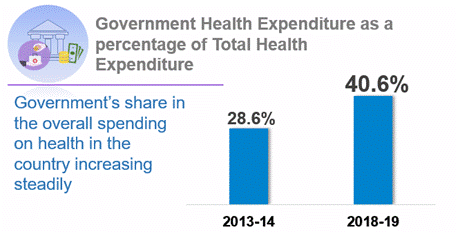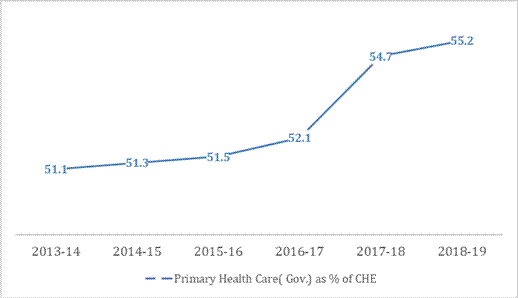Dr. Vinod K. Paul, Member (Health) of NITI Aayog, in presence of Shri Rajesh Bhushan, Secretary, Union Ministry of Health & Family Welfare released findings of the National Health Accounts (NHA) Estimates for India for 2018-19. In a significant update, various indicators related to health expenditure in the country have shown encouraging trend, which has been demonstrated on a sustained basis.
The NHA estimates for 2018-19 show that there has been an increase in the share of government health expenditure in the total GDP of the country. It has increased from 1.15% in 2013-14 to 1.28% in 2018-19.


Figure : Government Health Expenditure as % of GDP
Additionally, the share of Government Health Expenditure in Total Health Expenditure has also increased over time. In 2018-19, the share of government expenditure was 40.6%, substantially higher than the share of 28.6% in 2013-14.

NHA findings also indicate that Government’s health expenditure as a percentage of Current Health Expenditure has increased from 23.2% in 2013-14 to 34.5% in 2018-19.

It has also been observed that per capita government spending on healthcare has increased by 74% since 2013-14, i.e., Rs. 1042 to Rs. 1815 in 2018-19.

Aligning with the focus on providing healthcare services to all which comprises one of the policy recommendations of the National Health Policy (NHP) 2017, government is focusing on primary healthcare expenditure which has increased from 51.1% in 2013-14 to 55.2% in 2018-19.
Primary and secondary care accounts for more than 80% of the current Government Health Expenditure. In case of the private sector, the share of tertiary care has increased but primary and secondary care show a declining trend. Between 2013-14 and 2018-19, in government, the share of primary and secondary care has increased from 74% to 86%. On the other hand, in the private sector, the share of primary and secondary care has declined from 82% to 70% during the same period.

Figure: Share of Primary Health Care in Current Government Health Expenditure (%)

Due to several such steps, consequently, out-of-Pocket Expenditure (OOPE) as percentage of total health expenditure has declined substantially by 16% points, from 64.2% to 48.2%.

Out of pocket expenditure as a percentage of current health expenditure has also declined over time from 69.1% in 2013-14 to 53.2% in 2018-19.

Per capita out-of-pocket expenditure in the country has decreased by 8% since 2013-14, from Rs. 2,366 to Rs. 2,155 currently.

Focusing on social security has resulted in expenditure on health as a percentage of total health expenditure growing from 6% to 9.6% now.

The NHA also reveals that the government-financed health insurance expenditure has increased by 167% since 2013-14.

The NHA estimates for 2018-19 also indicate falling reliance on external funding in the health sector of the country. The findings from the report depict that foreign aid for health has come down to 0.4% in 2018-19 from 2.3% in 2004-05, showcasing India’s economic self-reliance.
Table 1: Trends in broad health financing and macroeconomic indicators
|
Indicators
|
2017-18
(in Rs Crores)
|
2018-19
(in Rs Crores)
|
Percentage change
|
|
Gross Domestic Product (GDP)
|
1,70,90,042
|
1,88,99,668
|
11%
|
|
General Government Expenditure (GGE)
|
45,15,946
|
50,40,707
|
12%
|
|
Total Health Expenditure (THE)
|
5,66,644
|
5,96,440
|
5%
|
|
Government Health Expenditure (GHE)
|
2,31,104
|
2,42,219
|
5%
|
“It is truly a moment of pride that we have in our nation a systematic, robust, reliable transparent accounts and accounting of spending on health. Such reports will help us with clear decision-making processes in line with National Health Policy recommendation of 2017.” Dr. V K Paul stated this while congratulating everyone on NHA Estimates report launch which is sixth consecutive since 2013-14. He said that National Health Systems Resource Centre (NHSRC) has ensured that all such reports are published without any interruption and follows academic rigor along with robust methodology and approach. Since, these reports are used by researchers, policy makers and program implementors, therefore, their robustness is critical.
Dr. Paul noted that the guiding principle of government from last few years has been to reduce out-of-pocket expenditure (OOPE) on health by citizens, which pushes individuals and families into poverty. As per National Health Account Estimates 2018-19 launched today, OOPE has substantially declined by almost 16% points as a percentage of current health expenditure from 2014 to 2018-19. Even in the case of per capita OOPE, there has been a decline. The report also provides a comparison of the per-capita OOPE of India with other countries, using Global Health Expenditure Database provided by WHO. In the group of 189 countries, India ranks 66th for per capita OOPE.
Union Health Secretary Shri Rajesh Bhushan focused on the significant shift in the nature of government expenditure. The increased focus on primary health care reinforces government’s decision to prioritize primary healthcare in the country. The report captures that 55.2% of the government expenditure currently has been on primary health. This not only ensures quality services at the grassroot level but also reduces the chances of ailments requiring secondary or tertiary healthcare services, he pointed out.
Shri Rajesh Bhushan also focused on the social security expenditure on health as a percentage of the total health expenditure. The social security expenditure on health which includes the social health insurance program, government-financed health insurance schemes, and medical reimbursements made to government employees, has increased from 6% in 2013-14 to 9.6% in 2018-19. This is a significant increase which shows that the common people of India are better equipped and better provided in terms of healthcare at their doorstep and making health more accessible.
About National Health Account (NHA) estimates:
The National Health Account (NHA) estimates for India 2018-19 is the sixth consecutive NHA estimates report prepared by NHSRC, designated as National Health Accounts Technical Secretariat (NHATS) in 2014 by the Union Health Ministry. The NHA estimates are prepared by using an accounting framework based on the internationally accepted standard of System of Health Accounts, 2011, developed by the World Health Organization (WHO).
With the present estimate of NHA, India now has a continuous series of NHA estimates for the country, from 2013-14 to 2018-19. These estimates are not only comparable internationally, but also enable the policymakers to monitor the progress in different health financing indicators of the country. The report can be accessed here: https://nhsrcindia.org/national-health-accounts-records.
****
MV
HFW/National Health Estimates 2018-19 report launch/12 Sept 2022/4